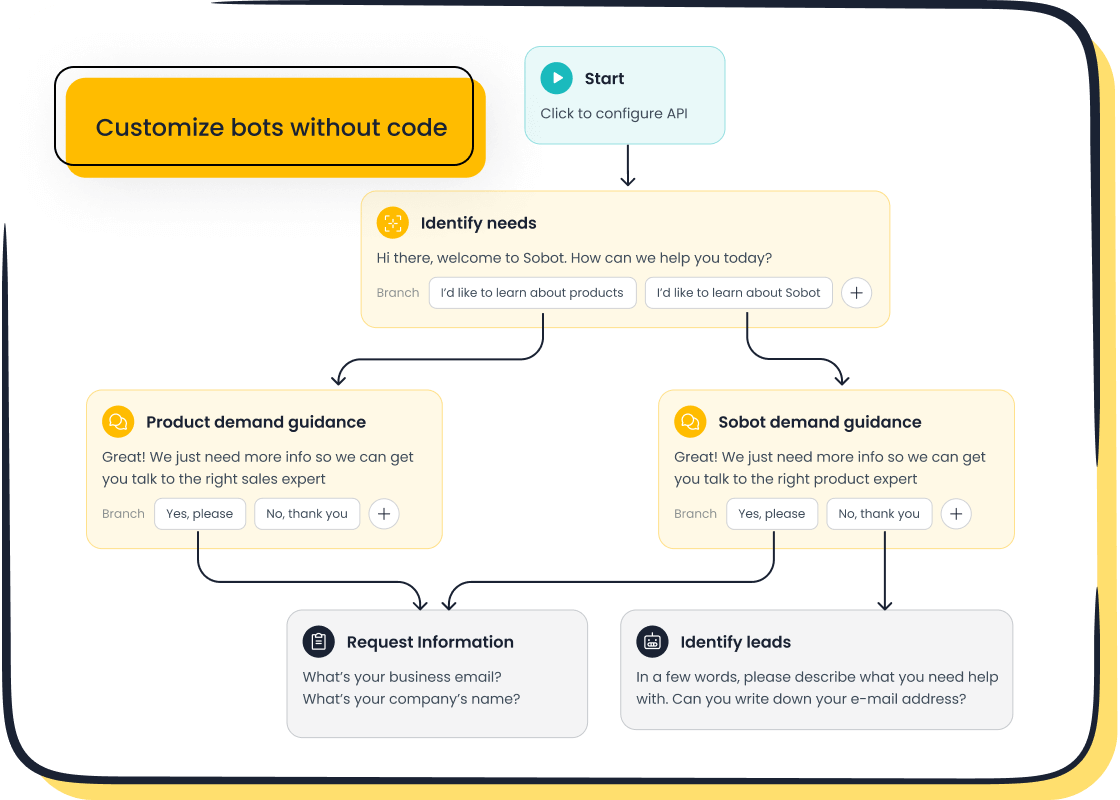Explore Leading APIs for Sentiment Analysis Score

Understanding how your customers feel is essential for delivering exceptional service. Sentiment Analysis Score (SA) helps you uncover emotions embedded in customer feedback, enabling you to respond effectively. Whether it's a glowing review or a frustrated complaint, identifying the sentiment behind the words can revolutionize your support strategy.
APIs make this process effortless. They integrate data from various sources, such as social media or surveys, and calculate Sentiment Analysis Scores (SA) with precision. For instance, Sprout Social's API evaluates social media interactions, while Qualtrics generates sentiment scores for specific themes. These tools process large datasets, ensuring accurate and actionable insights.

Sobot elevates this capability with its AI-powered Chatbot. It not only automates responses but also leverages Sentiment Analysis Score (SA) to optimize customer interactions. This ensures your customers feel acknowledged and valued, every single time.
Understanding Sentiment Analysis and Its Role in Customer Service

What is Sentiment Analysis?
Definition and significance
Sentiment analysis is the process of using AI to identify emotions in text. It helps you understand whether a piece of text conveys positive, negative, or neutral feelings. This technique is widely used in customer service to analyze feedback, reviews, and interactions. By understanding customer emotions, you can address concerns, improve experiences, and build stronger relationships. For example, a sentiment analysis tool can detect frustration in a customer’s email, allowing you to respond with empathy and resolve the issue quickly.
How sentiment analysis scores (sa) are calculated
Sentiment scores are calculated by analyzing words, phrases, and context in a text. APIs use machine learning models to assign a numerical value to the sentiment. Positive sentiment gets a high score, while negative sentiment receives a low one. For instance, if a customer writes, "I love how fast your service is," the sentiment score will reflect a positive sentiment. These scores help you prioritize responses and improve your customer service strategy.
Applications in Customer Service
Enhancing customer support with real-time analysis
Real-time analysis of customer feedback allows you to address issues as they arise. For example, a large mobile provider used sentiment analysis to identify unhappy customers during call center interactions. Low sentiment scores triggered immediate follow-ups, reducing churn and improving satisfaction. Similarly, Gousto used sentiment analysis to monitor feedback across channels, enabling faster and more effective responses.
Improving customer satisfaction and success
Sentiment analysis tools play a key role in boosting customer satisfaction. They help you recognize frustrations, resolve them proactively, and align your services with customer expectations. British Airways Holidays, for instance, analyzed thousands of reviews to improve their service, leading to happier customers. By understanding emotions, you can create a more personalized and successful customer experience.
Benefits of Sentiment Analysis Tools
Data-driven decision-making
Sentiment analysis tools provide valuable insights for making informed decisions. They help you prioritize feedback, allocate resources effectively, and identify trends. For example, data visualization tools can highlight recurring issues in customer feedback, allowing you to address them promptly. This approach not only improves your services but also strengthens your brand reputation.
Real-time insights for proactive customer engagement
With real-time insights, you can engage customers proactively. Sentiment analysis tools enable you to detect dissatisfaction early and take corrective actions. For instance, APIs integrated with text analysis tools can analyze social media comments instantly, helping you prevent negative experiences. This proactive approach fosters loyalty and enhances customer satisfaction.

Why APIs Are Essential for Sentiment Analysis
Key Advantages of Sentiment Analysis APIs
Scalability and automation
APIs bring unmatched scalability and automation to sentiment analysis. Imagine processing thousands of customer reviews or social media comments in seconds. APIs make this possible. They can handle massive datasets without breaking a sweat, scaling from a single post to millions. For example, some APIs process over 500 posts per second, ensuring you never fall behind on customer feedback. This speed doesn’t compromise quality either. With initial accuracy rates of 75%, APIs improve to 90% when trained on your data. Real-time sentiment analysis becomes a reality, allowing you to act on insights instantly.
Integration with customer service platforms
APIs seamlessly integrate with your existing tools, like CRM systems or social media monitoring platforms. This integration ensures a smooth workflow. For instance, you can connect an API to your customer service software to analyze live chat conversations. If a customer expresses frustration, the system can alert your team immediately. This proactive approach improves response times and customer satisfaction. Sobot’s AI-powered Chatbot is a great example. It uses sentiment analysis APIs to detect emotions and tailor responses, creating a more personalized experience.
Features to Look for in the Best Sentiment Analysis APIs
Accuracy and language support
Accuracy is critical when choosing a sentiment analysis API. You want a tool that understands the nuances of language. Many APIs start with 75% accuracy but can reach 90% with proper training. Multilingual support is equally important. APIs that process languages natively deliver better results than those relying on translations. For example, tools like Repustate excel in analyzing social media sentiment analysis across 22 languages. This feature is essential if your business serves diverse markets.
Customization and flexibility
Every business has unique needs, and your sentiment analysis tools should adapt to them. Look for APIs that allow customization. For instance, you might want to focus on specific keywords or industry jargon. Flexible deployment options, like on-premise or cloud-based solutions, also matter. They ensure you can maintain data quality and security while meeting your operational requirements. Customization improves the depth of insights, making your sentiment analysis more relevant and actionable.
Use Cases for Sentiment Analysis APIs
Monitoring customer feedback in real-time
Real-time sentiment analysis helps you stay ahead of customer concerns. Retailers, for example, use APIs to categorize feedback as positive, negative, or neutral. This categorization allows them to address issues immediately, improving customer satisfaction. APIs also provide valuable insights into trends, helping you refine your products or services. Sobot’s omnichannel solutions excel in this area, offering tools that unify customer interactions and enhance service quality.
Analyzing social media sentiment for brand reputation
Social media sentiment analysis is vital for protecting your brand’s reputation. APIs can scan platforms like Twitter or Facebook to gauge public opinion. For instance, a tourism company might use an API to analyze reviews and comments about a new travel package. If negative sentiment spikes, they can adjust their strategy quickly. This proactive approach not only safeguards your brand but also builds trust with your audience.
Top Sentiment Analysis APIs for Customer Service

Google Cloud Natural Language API
Features and capabilities
The Google Cloud Natural Language API offers robust sentiment analysis tools that can process text from various sources like emails, reviews, and social media. It uses machine learning to detect sentiment, entity recognition, and syntax analysis. This API supports multiple languages, making it ideal for businesses with a global audience. Its integration with other Google Cloud services ensures seamless workflows, especially for companies already using Google’s ecosystem.
Pricing and subscription models
Google Cloud Natural Language API uses a pay-as-you-go pricing model. You only pay for the number of text units analyzed, making it cost-effective for businesses of all sizes. Free tier options are available, allowing you to test the API before committing to a paid plan.
Best use cases
This API is perfect for analyzing customer reviews, monitoring social media sentiment, and enhancing customer service interactions. For example, a retail company can use it to identify trends in customer feedback and adjust its strategies accordingly.
IBM Watson Natural Language Understanding
Features and capabilities
IBM Watson Natural Language Understanding excels in providing detailed sentiment analysis. It can analyze text for emotions, keywords, and categories, offering deep insights into customer feedback. Its ability to process unstructured data makes it a versatile tool for various industries.
Pricing and subscription models
IBM Watson offers flexible pricing plans, including a free tier for small-scale usage. Paid plans start at competitive rates, scaling based on the volume of text analyzed. Over three years, businesses have reported significant cost savings of $6.13 million and a 383% ROI.
Best use cases
This API is ideal for businesses looking to improve customer satisfaction and operational efficiency. For instance, it can help a financial service provider like Opay analyze customer inquiries and enhance service delivery.
Microsoft Azure Text Analytics
Features and capabilities
The Microsoft Text Analytics API delivers high accuracy and scalability. It can handle large volumes of text data and offers customizable models for specific needs. Its seamless integration with other Microsoft Azure services makes it a powerful choice for businesses already using Azure.
Pricing and subscription models
Microsoft Azure Text Analytics offers flexible pricing based on usage. While it provides excellent scalability, it may require technical expertise for setup. Businesses should weigh the cost against the benefits of its high accuracy and flexibility.
Best use cases
This API is well-suited for analyzing customer feedback in real-time and monitoring brand reputation on social media. For example, a tourism company could use it to gauge public opinion about a new travel package and adjust its marketing strategy.
Amazon Comprehend
Features and capabilities
Amazon Comprehend offers powerful tools for sentiment analysis, making it a go-to API for businesses. It identifies emotions like positive, negative, neutral, or mixed sentiments with confidence scores. This API goes a step further by providing targeted sentiment analysis, which pinpoints specific entities within the text. For example, if a customer review mentions "delivery" and "product quality," the API can analyze the sentiment for each entity separately. This granularity helps you understand customer feedback more deeply. Amazon Comprehend also supports multiple languages, making it suitable for global businesses.
Pricing and subscription models
Amazon Comprehend uses a character-based pricing model. You can process up to 50,000 units (5 million characters) per month for free during the first 12 months if you're a new or existing AWS customer. After that, charges apply based on usage, with a minimum of 300 characters per request. This flexible pricing ensures you only pay for what you use, making it cost-effective for businesses of all sizes.
Best use cases
This API is ideal for businesses that need to analyze large volumes of text data. For instance, e-commerce platforms can use it to evaluate customer reviews and identify trends in product feedback. It’s also great for monitoring social media sentiment to protect your brand's reputation. With its ability to handle multilingual data, Amazon Comprehend is perfect for companies operating in diverse markets.
Sobot Chatbot for Sentiment Analysis
Features and capabilities
The Sobot Chatbot takes sentiment analysis to the next level by combining AI-powered tools with real-time analytics. It evaluates customer interactions to gauge emotions and prioritize urgent issues. Its knowledge base management feature allows you to organize and update support content effortlessly. The chatbot also uses intelligent routing to direct inquiries to the right agent, ensuring faster resolutions. With scalable infrastructure, it handles high interaction volumes, making it a reliable choice for growing businesses.
| Feature | Description |
|---|---|
| AI-powered tools | Analyze customer interactions to gauge emotions and prioritize issues. |
| Knowledge base | Simplifies the creation and management of support content. |
| Real-time analytics | Tracks key performance indicators and customer behavior insights. |
| Sentiment analysis | Detects emotions during interactions and flags urgent cases. |
| Intelligent routing | Directs inquiries to the most suitable agent for faster resolutions. |
| Scalable infrastructure | Handles high volumes of interactions and grows with your business needs. |
How it enhances customer service interactions
The Sobot Chatbot transforms customer service by using sentiment analysis to personalize interactions. It detects emotions in real time, allowing you to address concerns proactively. For example, if a customer expresses frustration, the chatbot can escalate the issue to a human agent immediately. This ensures customers feel heard and valued. By automating routine queries, the chatbot also frees up your team to focus on complex issues, improving overall efficiency.
Best use cases for businesses
The Sobot Chatbot is perfect for businesses looking to enhance customer satisfaction while reducing costs. Retailers can use it to handle high volumes of inquiries during peak seasons. Financial service providers, like Opay, have leveraged its capabilities to improve customer satisfaction rates by 30%. Its multilingual support makes it ideal for global companies aiming to provide consistent service across regions.
Comparing the Best Sentiment Analysis APIs
Feature Comparison
Accuracy and language support
When choosing a sentiment analysis api, accuracy and language support are critical. You want a tool that processes text quickly and delivers precise results. For instance:
- A reliable api should process at least 500 posts per second. Repustate’s tool handles up to 1,000 comments per second and scales to millions of documents.
- Accuracy starts at 75% but can improve to 90% with proper training. Repustate even surpasses this benchmark with its advanced features.
- Multilingual capabilities are essential. An api supporting 23 languages with specific models ensures accurate sentiment scoring without relying on translations.
These features make an api indispensable for businesses serving diverse markets or handling large datasets.
Ease of integration with customer service tools
Integration is another key factor. A good api should work seamlessly with your existing systems. For example, Sobot’s AI-powered Chatbot uses sentiment analysis to detect emotions and prioritize responses. This integration allows you to address customer concerns in real time. Whether you’re using a CRM or a live chat platform, an api that fits effortlessly into your workflow saves time and enhances efficiency.
Pricing Comparison
Free tiers vs. paid plans
Pricing varies widely among sentiment analysis apis. Some offer free tiers, while others charge based on usage. Here’s a quick comparison:
| API Name | Free Tier | Paid Plan (Starter) | Paid Plan (Growth) |
|---|---|---|---|
| Google NLP API | Yes | N/A | N/A |
| Canny | Yes | $79/month | $359/month |
Google NLP API’s free tier is great for testing, but costs can add up for large documents. Canny provides scalable pricing, making it suitable for growing businesses.
Cost-effectiveness for businesses
Cost-effectiveness depends on your needs. If you’re analyzing small datasets, a free tier might suffice. For larger volumes, paid plans with scalable pricing are better. APIs like Amazon Comprehend offer flexible character-based pricing, ensuring you only pay for what you use. This approach makes it easier to manage costs while gaining valuable insights.
Choosing the Right Sentiment Analysis API for Your Business
Assessing Your Business Needs
Volume of data and customer interactions
Before selecting a sentiment analysis API, think about the volume of data your business handles daily. Are you processing thousands of customer reviews or just a handful of emails? High data volumes require APIs that can scale efficiently without driving up costs. For instance, if your business deals with real-time customer interactions, like live chats or social media comments, you’ll need an API that supports rapid processing and low latency.
Industries like healthcare and finance often require real-time processing for critical applications, such as fraud detection or patient care. On the other hand, batch processing might work for industries like manufacturing, where analyzing production data can happen periodically. Evaluating your data needs ensures you choose an API that aligns with your operational goals.
Industry-specific requirements
Every industry has unique challenges. For example, healthcare providers need APIs that comply with strict data security regulations, while e-commerce platforms prioritize APIs that enhance personalized recommendations. Financial services often merge customer data to make informed decisions on loans or investments.
APIs like IBM Watson and Aylien offer customization options to fit these specific needs. They allow you to adjust parameters, ensuring the analysis is accurate and relevant to your industry. Flexible deployment options, such as on-premise or cloud-based solutions, also cater to varying security and maintenance requirements.
Evaluating API Features
Customization options for customer service
The best sentiment analysis APIs let you tailor their features to your business. Customization ensures the API understands your industry jargon and focuses on the metrics that matter most to you. For instance, Sobot’s AI-powered Chatbot uses sentiment analysis to detect emotions and prioritize urgent issues. This level of customization helps businesses deliver more personalized and effective customer service.
Additionally, APIs with user-friendly reporting dashboards make it easier to visualize insights. These dashboards help you track trends and make data-driven decisions, improving your overall strategy.
Integration with tools like Sobot Chatbot
Seamless integration is key when choosing an API. It should work effortlessly with your existing tools, like CRM systems or live chat platforms. For example, Sobot Chatbot integrates with sentiment analysis APIs to detect customer emotions in real time. This integration allows you to address concerns proactively, enhancing customer satisfaction.
By combining sentiment analysis with tools like Sobot Chatbot, you can automate routine tasks while focusing on complex customer issues. This not only saves time but also boosts efficiency.
Testing and Implementation
Free trials and demos
Testing an API before committing is crucial. Many providers, like IBM Watson and Aylien, offer free trials or demos. These trials let you evaluate the API’s performance, accuracy, and ease of use. For example, IBM Watson’s Lite plan provides the first 30,000 items for free, giving you ample opportunity to test its capabilities.
During testing, focus on metrics like response time, error rate, and throughput. A slow or unreliable API can negatively impact your customer experience, so it’s essential to ensure the API meets your expectations.
Ensuring compatibility with existing systems
Compatibility with your current systems is non-negotiable. An API should integrate smoothly without requiring extensive modifications. Performance metrics like concurrency and resource utilization can help you assess whether the API will work well with your infrastructure.
For instance, Sobot’s omnichannel solutions ensure seamless integration across various platforms, making it easier to unify customer interactions. Testing compatibility upfront saves you from potential headaches during implementation.
Sentiment analysis has transformed how businesses approach customer service. It helps you understand emotions in feedback, enabling proactive and personalized support. Tools like SentiSum have shown how identifying friction points can improve Customer Satisfaction (CSAT) and Net Promoter Scores (NPS). APIs like Google Cloud Natural Language and Amazon Comprehend make this process seamless by analyzing vast amounts of data in real time.
Sobot Chatbot takes it further by combining sentiment analysis with intelligent automation. It detects emotions, prioritizes issues, and ensures every customer feels valued.
Explore these APIs and Sobot Chatbot to elevate your customer interactions and build stronger relationships. Learn more at Sobot Chatbot.
FAQ
What is the main purpose of sentiment analysis APIs?
Sentiment analysis APIs help you understand customer emotions by analyzing text data. They assign sentiment scores to feedback, reviews, or messages, enabling you to respond effectively. For example, Sobot Chatbot uses these APIs to detect frustration in real time and escalate issues to agents for faster resolutions.
How do sentiment analysis APIs improve customer service?
These APIs provide real-time insights into customer emotions. They help you prioritize urgent issues, personalize responses, and enhance satisfaction. For instance, Sobot’s AI-powered Chatbot uses sentiment analysis to identify unhappy customers and resolve their concerns quickly, boosting loyalty and retention.
Can sentiment analysis APIs handle multiple languages?
Yes, many APIs support multiple languages. This feature is essential for businesses serving global markets. Sobot Chatbot, for example, offers multilingual support, ensuring consistent service quality across regions. It helps you connect with customers in their preferred language, improving communication and satisfaction.
Are sentiment analysis APIs easy to integrate?
Most APIs integrate seamlessly with tools like CRMs or live chat platforms. Sobot Chatbot, for instance, connects effortlessly with sentiment analysis APIs to detect emotions during interactions. This integration streamlines workflows and ensures you can act on insights without disrupting your existing systems.
How do I choose the right sentiment analysis API for my business?
Start by assessing your data volume and industry needs. Look for features like accuracy, customization, and language support. Sobot Chatbot combines these features with intelligent automation, making it a versatile choice for businesses aiming to enhance customer service and reduce costs.
See Also
Best 10 Speech Analysis Tools for Call Centers in 2024
Leading 10 AI Solutions for Enterprise Contact Centers
Comparative Review of Leading Voice of Customer Software
